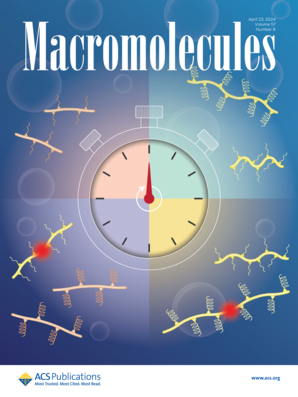Pyrene-Decorated Thermally Responsive Luminescent Nanoparticles: The Effect of Copolymer Micelle Morphology
IF 5.1
1区 化学
Q1 POLYMER SCIENCE
引用次数: 0
Abstract
Pyrene and its derivatives are widely utilized for their fluorescent behavior, and excimer formation allows the study of molecular structural behavior. Hence, it was hypothesized that surface-decorated block copolymer nano-objects would make suitable materials for studying such interactions. Pyrene-decorated polymer nano-objects were successfully synthesized through reversible addition–fragmentation chain-transfer (RAFT)-mediated polymerization-induced self-assembly (PISA). Specifically, various morphologies (spheres, worms, and vesicles) of pyrene-functionalized poly(glycerol methacrylate-b-hydroxypropyl methacrylate) (Py-P(GMA-b-HPMA)) were prepared by precisely controlling the degree of polymerization of the core-forming PHPMA block and temperature. These pyrene-functionalized nano-objects were used to study the influence of morphology on their photoluminescent behavior by comparing the emission intensity ratio between pyrene excimers (Ie) and monomers (Im). It was found that with increasing particle size or transitioning to higher-order morphologies, Ie/Im increased due to lower surface curvature. Thus, pyrene end-functional block copolymers serve as useful fluorescent probes to investigate changes in nanoparticle morphology and aggregation.

芘修饰的热响应发光纳米粒子:共聚物胶束形态的影响
芘及其衍生物因其荧光特性而被广泛应用,准分子的形成使得研究分子结构行为成为可能。因此,假设表面修饰的嵌段共聚物纳米物体将成为研究这种相互作用的合适材料。通过可逆加成-碎片链转移(RAFT)介导的聚合诱导自组装(PISA),成功合成了芘修饰的聚合物纳米物体。具体来说,通过精确控制聚核PHPMA块的聚合度和温度,制备了各种形态(球体、蠕虫和囊泡)的芘功能化聚(甲基丙烯酸甘油-b-羟丙基甲基丙烯酸酯)(Py-P(GMA-b-HPMA))。通过比较芘准分子(Ie)和单体(Im)的发射强度比,研究了形貌对芘功能化纳米物体光致发光行为的影响。随着颗粒尺寸的增大或向高阶形貌过渡,由于表面曲率的降低,Ie/Im增加。因此,芘端官能嵌段共聚物作为有用的荧光探针来研究纳米颗粒形态和聚集的变化。
本文章由计算机程序翻译,如有差异,请以英文原文为准。
求助全文
约1分钟内获得全文
求助全文
来源期刊

Macromolecules
工程技术-高分子科学
CiteScore
9.30
自引率
16.40%
发文量
942
审稿时长
2 months
期刊介绍:
Macromolecules publishes original, fundamental, and impactful research on all aspects of polymer science. Topics of interest include synthesis (e.g., controlled polymerizations, polymerization catalysis, post polymerization modification, new monomer structures and polymer architectures, and polymerization mechanisms/kinetics analysis); phase behavior, thermodynamics, dynamic, and ordering/disordering phenomena (e.g., self-assembly, gelation, crystallization, solution/melt/solid-state characteristics); structure and properties (e.g., mechanical and rheological properties, surface/interfacial characteristics, electronic and transport properties); new state of the art characterization (e.g., spectroscopy, scattering, microscopy, rheology), simulation (e.g., Monte Carlo, molecular dynamics, multi-scale/coarse-grained modeling), and theoretical methods. Renewable/sustainable polymers, polymer networks, responsive polymers, electro-, magneto- and opto-active macromolecules, inorganic polymers, charge-transporting polymers (ion-containing, semiconducting, and conducting), nanostructured polymers, and polymer composites are also of interest. Typical papers published in Macromolecules showcase important and innovative concepts, experimental methods/observations, and theoretical/computational approaches that demonstrate a fundamental advance in the understanding of polymers.
 求助内容:
求助内容: 应助结果提醒方式:
应助结果提醒方式:


